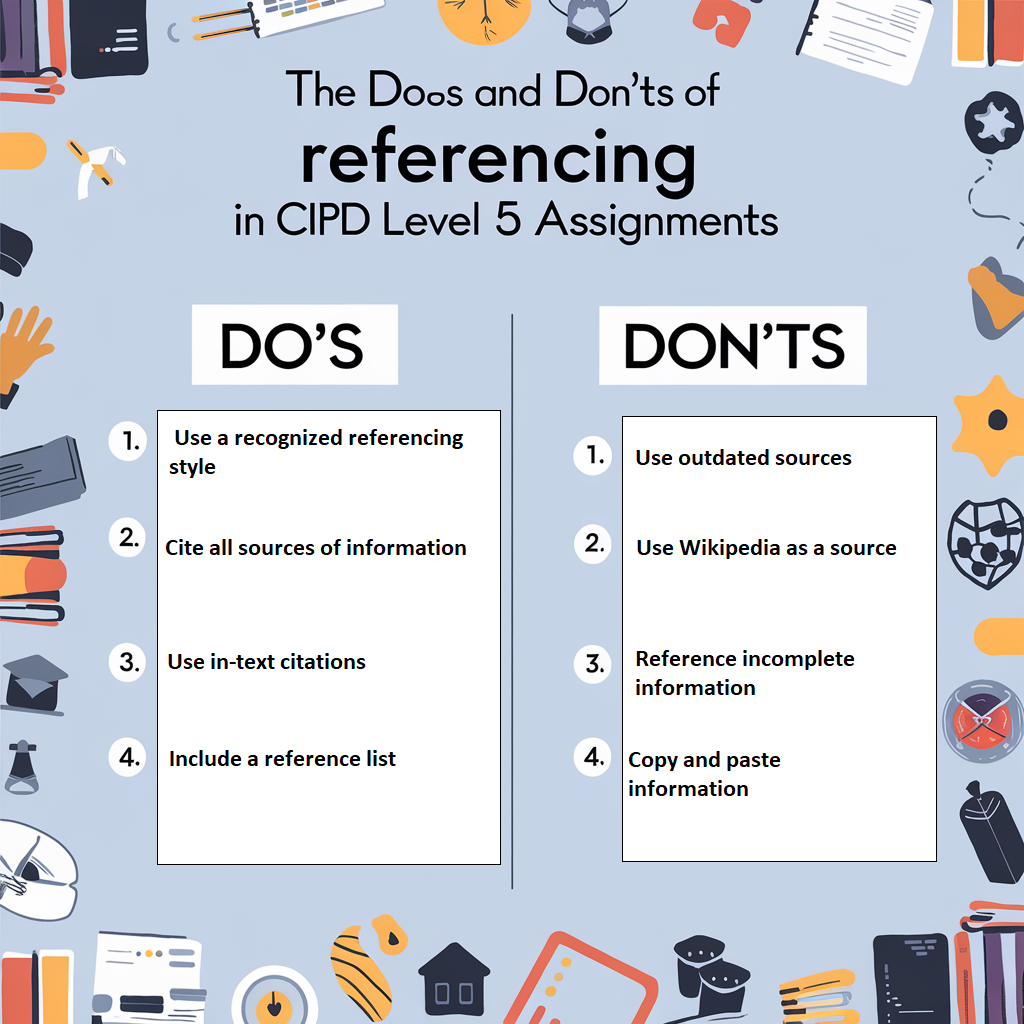As a CIPD Level 5 student, referencing is essential to your assignment writing process. Referencing is a way of giving credit to the sources you have used in your work and demonstrating that you have conducted research from credible and reliable sources.
It is essential to reference correctly because failure to do so can lead to accusations of plagiarism, which is a serious academic offence that can result in a failing grade or even expulsion from your course.
Read more on CIPD assignment writing tips for success
The following are some dos and don’ts of referencing in CIPD Level 5 assignments that you should keep in mind,
Dos
1. Use a recognized referencing style
The CIPD recommends using the Harvard referencing style for your assignments. This style is commonly used in academic writing and is recognized by universities and educational institutions worldwide. The Harvard style uses in-text citations and a reference list at the end of your work. Using a recognized referencing style ensures consistency in your citations and avoids losing marks for errors.
Example: (Kim, 2019) for in-text citation and Kim, J. (2019) for the reference list.
2. Cite all sources of information
You should reference all sources of information you have used in your assignment, including books, journal articles, websites, and other sources. Ensure you include all relevant information, including the author’s name, publication date, title, and page number. You should also reference any data or statistics used in your work.
Example: If you are citing a book, your reference would look like this:
- In-text citation: (Johnson, 2015, p. 56)
- Reference list: Johnson, T. (2015). Human Resource Management. London: Kogan Page.
3. Use in-text citations
In-text citations acknowledge the source of a direct quote or paraphrase. For example, they should include the author’s surname and the year of publication (Kim, 2015). In-text citations are important because they show the reader where the information came from and allow them to find the source in the reference list.
Example: In-text citation for paraphrasing – According to Kim (2015), recruitment technology has become increasingly popular.
4. Include a reference list
A reference list should be included at the end of your assignment. This should consist of all the sources of information that you have used in your work. The reference list should be arranged alphabetically by the author’s surname. Ensure you use the correct formatting and punctuation for your reference list.
Example:
- Book: Kim, J. (2019). Human Resource Management. London: Routledge.
- Journal article: Johnson, T. (2017). Recruitment and selection. Journal of Human Resource Management, 20(2), 56-65.
- Website: CIPD. (2019). Retrieved from https://www.cipd.co.uk
5. Check your referencing
Before submitting your assignment, check your referencing to ensure it is accurate and complete. You can use online referencing tools like Cite This For Me or RefME to help you with this. These tools can help you to create a reference list quickly and accurately.
Example: Use an online tool like Cite This For Me to automatically generate your reference list.
Check on Mistakes Students Make in CIPD Assignments
6. Follow Alphabetical Order
Arrange your reference list in alphabetical order by the author’s surname. This makes it easy for examiners to verify your sources.

Don’ts
1. Copy and paste information.
Copying and pasting information from a source without acknowledging the source is a form of plagiarism. You should always paraphrase information in your own words and acknowledge the source. Make sure that you use quotation marks when you are









 Evan John
Evan John